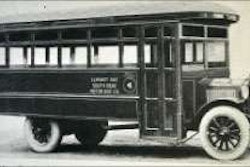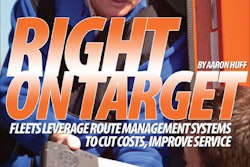Seeing the light
Overcome sticker shock before ruling out LEDs
When it comes to comparing new lighting technology, most lighting experts see LEDs as the high-tech future of headlamps over high-intensity discharge (HID) technology. “LED has legs, so that’s where all the research money is going,” says Page Large, Grote Industries’ national fleet sales manager.
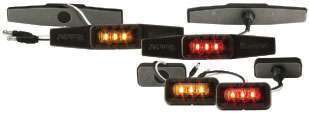 The low current draw of LEDs provides the ability to operate marker lights such as Truck-Lite’s Model 36 Flex Lamp while the truck is turned off without draining the batteries.
The low current draw of LEDs provides the ability to operate marker lights such as Truck-Lite’s Model 36 Flex Lamp while the truck is turned off without draining the batteries.Besides longer life and instant-on capability, LEDs also have less potential for damage and include less consumable material. LED color temperature is similar to the sun, more toward blue-white than red-orange. “That means more visibility because you see more different colors reflected for the same amount of light energy or lumens,” says Brad Van Riper, Truck-Lite’s senior vice president of research and development.
While major truck lighting manufacturers see LED headlamps as a long-term solution, they also realize that LED affordability remains over the horizon for most fleets. “Our challenge is to get the cost down,” Van Riper says. The higher initial cost for LEDs yields 10,000 hours of life compared to 3,000 for halogens.
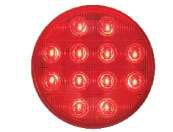 Optronics’ 4-inch-round LED stop-turn-tail light features high-quality diodes and circuitry sealed with epoxy to protect against moisture and corrosion.
Optronics’ 4-inch-round LED stop-turn-tail light features high-quality diodes and circuitry sealed with epoxy to protect against moisture and corrosion.HID lamps work by striking an arc of electricity that jumps across electrodes through a gas containing metal salts to promote conductivity and produce more light. Because they deliver a bright, white light of high intensity, they are considered a technological success – but unrealistic for fleets from an economic standpoint when halogens go for $25 or less, says Van Riper.
HID replacement cost averages $100 per headlight, and that’s only for designs where the ballast needed to make the light work is separate from the bulb; if combined, the price climbs closer to $300. Also, HIDs only last about as long as halogens, and both products have comparable energy consumption.
Spotlight on CSA 2010
Meanwhile, LED stop/tail, turn and marker lights are more affordable, which may make them more of a consideration as fleets prepare for the Federal Motor Carrier Safety Administration’s implementation of Comprehensive Safety Analysis 2010. “It’s important for fleets to consider how to best manage this change,” Large says.
In a recent list of the top 10 safety violations, two were lighting-related, Large says. Under CSA 2010, a light that isn’t working is worth six violation points. Retrofitting with longer-life LEDs likely would improve a fleet’s safety scores and reduce its chances of getting a ticket. “For some fleets, fewer citations could mean not being pushed over the edge in terms of receiving a poor safety rating,” Large says.
CSA 2010 also means it’s becoming more important to specify a robust lighting package complete with quality wiring, connections and insulation. Physical damage is one of the top failure modes for lighting, Van Riper says. “Replacing a system that uses older-style plugs alone can help ensure good reliability of the whole lighting system.”
Spec’ing lighting
When spec’ing lighting, fleets should consider the combination of longer life, less current draw and better visibility. Fuel savings are hard to quantify, but one safety advantage shows up when a driver shuts down the engine while parked in a spot close to heavy traffic; the low current draw of LEDs provides the ability to operate the marker lights while the truck is turned off without draining the batteries. “This is clearly a boon in an atmosphere where prolonged idling is so often taboo,” Van Riper says.
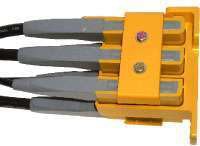 The Defender modular harness/lighting system from Maxi-Seal Harness Systems, a subsidiary of Peterson Manufacturing, features robust harness components and Peterson’s Piranha LED lights.
The Defender modular harness/lighting system from Maxi-Seal Harness Systems, a subsidiary of Peterson Manufacturing, features robust harness components and Peterson’s Piranha LED lights.Not only can LEDs be ordered on new equipment, retrofitting with them also has become a relatively painless possibility for a fleet’s bank account – less than $10 per light. Grote’s retrofit LEDs snap into an existing grommet – “You don’t need any special adapters or pigtails,” Large says – and are designed to look like incandescents. “Aesthetically, you can hardly tell the difference,” he says. “That means it does not scream, ‘Come steal me.’ ”
Peterson Manufacturing, which is developing trailer lighting systems that lower maintenance costs, has encountered a corrosion problem at the lamp connection, which is made worse in the winter by anti-icing agents such as calcium-chloride that often are added to road salt. Today’s modern hard-shell connectors provide longer life than older products because they help protect against corrosion. “Hard-wired LEDs that use these connectors are a very effective way to retrofit,” says Mark Assenmacher, Peterson’s director of marketing.
Not all LED lighting is created equally, says Nancy Eaton, marketing manager of Optronics International. The point of manufacture – domestic or import – is not as important as the components used in the manufacturing process; superior-quality lighting features the highest-quality diodes and circuitry sealed with epoxy to protect against moisture and corrosion, and compliance with U.S. Department of Transportation regulations also must be assured through routine testing. Upgrading from incandescent lighting to LEDs should pay for itself within one to two years, Eaton says.
Working with a major lighting manufacturer can yield additional benefits such as field service backed by years of product-specific research and experience. “When taking delivery of a large batch of trailers, invite the critical suppliers out to help inspect them,” says Van Riper, who recently found some taillights with the wiring under tension “like a guitar string” because it had been routed tightly along the side of a crossmember. “We helped the OEM find the proper routing and get a durable installation.” n


